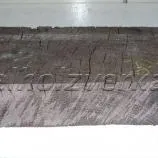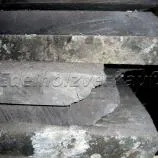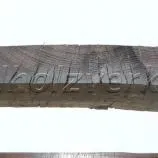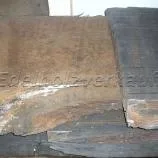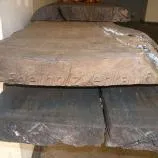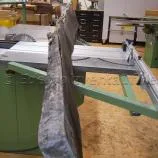Shipping country
Wood Species
Informations about Bog Oak
Bog oak is a fascinating material, since centuries this ancient and weird looking jet black material fascinated people and occupied their fantasies. The wood has been widely used in arts and crafts and is nowadays more than ever a precious wood, only high quality and fine objects, furniture parts and handicrafts are made from it. By long experience we have become experts in bog oak, so here are a few explanations for handling, storage and valuation of this intricate wood! Bog oak is not rare at all, almost every day logs are found in northern Europe, during earthworks in river courses and sand or gravel pits excavating machines dig out such logs, usually being a real nuisance to the workers. Once found stuck in the earth, they often are often extremely heavy and cannot be removed easily, often even a crane has to be fetched to help the hump to be removed. If this annoyance finally is removed, the chunk is retrieved and the work can be continued, but where to put the whopper? Even if the trunk is still reasonably intact and not heavily decomposed and cracked, a rapidly progressive process of decay and cracking starts, which can lead to complete destruction of the wood especially in warm weather or during frost in a short time. One can cover the logs by foils, but this almost always starts immediately putrefaction by fungus and mould growth, or one can irrigate the wood permanently with a lawn sprinkler and preserve the state for a while, but immediately milling by a sawmill into boards has been proven the safest method to save this valuable yet tricky timber. However, sawmill owners and workers are not popular with bog oak logs in most cases, there will always be sand or stones inside the log, and these will fairly reliable ruin any expensive saw blade...After being cut to boards the colour of the bog oak can be evaluated: most valuated of course is a deep jet black colour, but this colour only develops under some happy combinations of factors such as wood ingredients, iron ions in water, lack or exclusion of oxygen. Often bog oak logs only show dark yellowish grey to light brown colours, most are coloured brown to grey, which, of course, are significantly less rated colours. After being cut in the sawmill long years of storage in rooms with different humidity levels and air movement conditions follow for the boards. After several years the boards are then hopefully fairly seasoned, accompanied by a lot of times restacking, rearrangements in other rooms and a lot of patience, so that they may be exposed to normal climatic conditions. Under these normal conditions, the wood then dries down to a relative humidity of about 10%, thus, the bog oak can be processed as usual wood. During this air-seasoning the wood usually releases large internal tension whilst reducing the humidity from nearly 100 % down to only 10 %, that will cause extreme distortions, seasoning checks, severe cracks, heavy warping and all possible other distortions. You will find some photos of such pieces of crooked wood in the photo gallery. Thus, any drying of bog oak must take place really very slowly and gently and constant monitoring of the moisture content is essential. Despite utmost careful drying bog oak always contains more or less cracks, soft and punky rotten spots or parts discoloured by fungus have to be cut away, so in the end only about 30-50% of the salvaged wood can be gained. The waste rate of bog oak boards increases dramatically, the longer and bigger the dimensions of the desired blanks are. Cracks, checks, knots and other defects can even push the waste rate to 80 - 90%. We use these smaller chunks of wood for a variety of other purposes, and even when cutting fixed sizes, those small sections are grouped into assortments. This pre-fossile, thousands of years old magical wood is just worth to be met with special respect!





